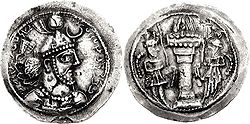Yazdegerd I.
Yazdegerd I. ( Persian یزدگرد Yazdgerd [ jæzdˈgʲerd ]) ruled from 399 to 420/421 and was a Persian great king of the Sassanid family .
Life
Yazdegerd (also Yazdgird ), who is nicknamed "the sinner" ( al-Athīm ) in Persian-Arabic tradition , was one of the most important late ancient Persian kings. In terms of foreign policy, the king acted very skillfully; His relations with the Romans were so good at the beginning that some Roman authors (especially Prokopios of Caesarea ) even report the story - which is very controversial in its historicity - that Emperor Arcadius made him the guardian and executor of his underage son Theodosius II in 408 , whereupon the king had sent a eunuch named Antiochus to Constantinople as his administrator. The eastern border with the Iranian Huns seems to have been stable during his reign.
Yazdegerd got his unflattering surname due to a tolerant policy towards the Persian Christians, to whom he first allowed an empire-wide council (in Ctesiphon ) in 410 , which must have aroused the displeasure of the Zoroastrian clergy. Even in the high nobility, the self-confident great king may have made enemies because he acted independently and was apparently an assertive ruler. In this sense, he restricted the power of the nobility, which is why he was unjustly vilified in later oriental tradition. In the Roman tradition, however, Yazdegerd is mostly portrayed very positively due to his tolerant religious policy; some western authors even falsely claim that he converted to Christianity himself.
Nevertheless, Christians were persecuted towards the end of his reign. However, this was provoked by the behavior of some Christians who had destroyed a fire temple . When the responsible bishop refused to have the damage repaired, the great king, at the urging of the Zoroastrian priests, was forced to take action against the Christians. In connection with this, a war with Ostrom broke out shortly before the king's death , but it remained without a clear winner and was soon ended by Yazdegerd's son and successor Bahram V.
Yazdegerd I died mysteriously (according to Tabari he was killed by a horse sent from heaven); there is much to suggest that he was murdered by a group of conspirators made up of priests and nobles who then covered up the incident. At first his son was refused his father's crown and another Sassanid named Chosrau was put on the throne, about whom nothing else is known. Only after long negotiations and with the military support of the Arab Lachmids was Bahram able to take power, whereby he had to make several concessions to the nobility.
The most important source for Yazdegerd's reign is the universal history of Tabari, who was able to access sources that are lost today, but whose assessment is distorted by the tendentious sources. In addition, there are some Western sources that are particularly important for the relationship with Rome.
literature
- Scott McDonough: A Second Constantine? The Sasanian King Yazdgard in Christian History and Historiography . In: Journal of Late Antiquity 1/1, 2008, pp. 127-140.
- Hubert Grimme : Iezdegerd 1 . In: Paulys Realencyclopadie der classischen Antiquity Science (RE). Volume IX, 1, Stuttgart 1914, Col. 961-964.
- Paul Sauerbrei: King Jazdegerd, the sinner, the guardian of the Byzantine emperor Theodosius the Little . In: Festschrift Albert von Bamberg on October 1, 1905, dedicated by the teaching staff of the Ernestinum Gymnasium in Gotha . Perthes, Gotha 1905, pp. 90-108.
- Nikolaus Schindel: Yazdgerd I. In: Nikolaus Schindel (Ed.): Sylloge Nummorum Sasanidarum . Vol. 3/1 (text volume). Vienna 2004, p. 318ff.
- Klaus Schippmann : Basic features of the history of the Sassanid Empire . Darmstadt 1990.
- Monika Schuol : Yazdgird I. and the Christians in the tradition of Socrates . In: E. Dabrowa (Ed.): Ancient Iran and its Neighbors . Krakau 2005, pp. 95-106 (= Electrum 10).
Web links
- Yazdegerd I. . In: Ehsan Yarshater (Ed.): Encyclopædia Iranica (English, including references)
Remarks
- ↑ Sauerbrei, King Jazdegerd , rejected the will as a legend. However, the opinion of more recent research is divided; see. for discussion Henning Börm : Prokop and the Persians. Investigations into the Roman-Sasanid contacts in late antiquity. Stuttgart 2007, p. 308ff.
- ↑ See Nikolaus Schindel: The Sasanian Eastern Wars in the 5th Century. The Numismatic Evidence. In: A. Panaino, A. Piras (Ed.): Proceedings of the 5th Conference of the Societas Iranologica Europaea. Volume I. Milan 2006, pp. 675-689, here p. 678.
- ↑ Review in McDonough, A Second Constantine?
- ↑ Theodor Nöldeke : History of the Persians and Arabs at the time of the Sasanids. From the Arab Chronicle of Tabari. Translated and provided with detailed explanations and additions . Leiden 1879, p. 77.
- ↑ Theodor Nöldeke: History of the Persians and Arabs at the time of the Sasanids. From the Arab Chronicle of Tabari. Translated and provided with detailed explanations and additions . Leiden 1879, p. 72ff .; Clifford Edmund Bosworth: Ṭabarī. The Sāsānids, the Byzantines, the Lakhmids, and Yemen . Albany / NY 1999, pp. 70-74.
- ↑ For a summary, see The Prosopography of the Later Roman Empire . Vol. 2. Cambridge 1980, p. 627.
| predecessor | Office | successor |
|---|---|---|
| Bahram IV. |
King of the New Persian Empire 399–421 |
Bahram V. |
| personal data | |
|---|---|
| SURNAME | Yazdegerd I. |
| ALTERNATIVE NAMES | یزدگرد (Persian); Yazdgerd |
| BRIEF DESCRIPTION | Great King of the Sassanid Empire (399–420 / 421) |
| DATE OF BIRTH | 4th century |
| DATE OF DEATH | 420 or 421 |
